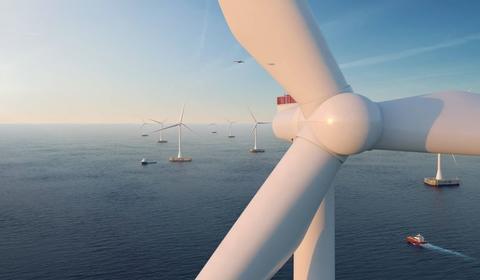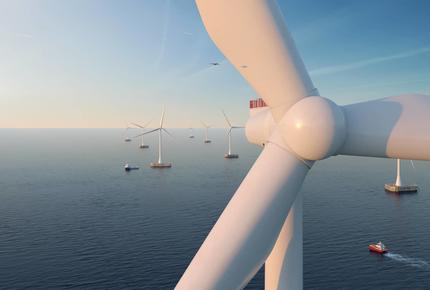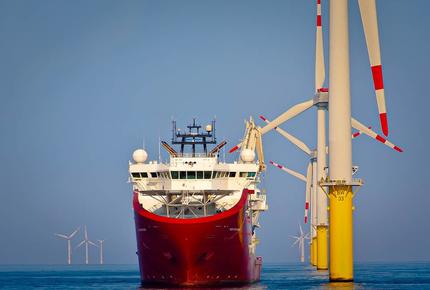
Behind the scenes on a floating offshore wind farm
Floating offshore wind farms (FOWF) are the rising star of the offshore renewables industry. Building on the technology developed for fixed-bottom turbines, FOWF enable operators to produce renewable energy at previously unexploitable depths.
This growing industry has drawn significant attention and investment worldwide, with commercial projects expected to begin production in 2023. For countries across Europe, Asia and the Americas, FOWF represent a crucial opportunity to meet increasing—and increasingly urgent—demands for renewable energy production.
However, enthusiasm must be balanced with pragmatism. Designing, developing, installing and operating FOWF requires offshore operators to account for a range of technical, logistical, environmental and safety concerns. Operators must also work with shipowners, who provide a range of specialized offshore vessels needed to build and install FOWF.
The steps in developing FOWF
Now a relatively mature market in terms of technology and construction, most floating offshore wind projects follow a common process for development and installation:
-
1. Permitting
FOWF projects begin with an assessment of the proposed site. Operators require an environmental permit, which evaluates the project’s impact on marine ecosystems, underwater life, the seabed and natural reserves. A project permit is also needed to establish the footprint of the project and its construction and installation plan. To obtain these permits, operators must comply with all regulatory frameworks and local regulations in place.
-
2. Development
Underwater and aerial surveys are conducted by monitoring the site’s meteorological conditions, including tides, waves and currents. Geotechnic and hydrographic surveys are carried out to map the seafloor and find obstacles. Experts can then determine the optimal wind farm layout, select turbines and foundations, design the electrical grid and choose an installation method. The duration of operations can be predicted through a probabilistic approach, using hindcast environmental data and a sequential downtime simulation. This gives a probability rating that assesses the impact of weather conditions on the project’s required operational time.
-
3. Detail design
Designers must optimize turbine stability and hydrodynamics, and conduct mooring and anchoring analyses to ensure the efficiency, security and economic viability of turbines. This work is complemented by structural analysis, anti-fouling precautions, and the encasing of power cables or cable trenching.
-
4. Manufacturing
Following production, the blades, mast and turbine must be transported offshore. To do this, floaters are assembled on deepwater quays by operational vessels. Preliminary anchors are installed and mooring lines are connected with the support of installation and crew transfer vessels.
-
5. Transportation
Specialized vessels are used to set up temporary floating systems. Tugboats can then deploy anchors and mooring lines, before towing floaters offshore.
-
6. Installation
A launching analysis is conducted to clear the way for turbine towing and installation. The anchor, floater and turbine are installed, and power cables are connected to the grid. This step is highly subject to impact from onsite weather conditions, which can be mitigated by preparation to ensure the project progresses as planned.
-
7. Maintenance
Once installed, floating wind farm operators must monitor platform stability, anchoring systems, and the condition of blades, rotors, masts, and underwater structures. Maintenance activities are supported by offshore service vessels (OSV), CTVs and tugboats. Remote Inspection Techniques can also be of use in fine-tuning the maintenance phase.
Our commitment to FOWF
From the earliest stages of development and design, Bureau Veritas Solutions – Marine & Offshore helps offshore operators build safe and compliant floating wind farms. We offer design review; technical studies; risk analysis; environmental assessments; and project management for platforms, mooring and anchor systems, and subsea cables. Some risks in wind farm transportation and installation also require knowledge of maritime procedures. Here, our teams are also able to support our clients, leveraging their lengthy experience in mitigating project development risks. Our maritime coordination expertise enables us to support wind farm installation, manage marine traffic studies and provide marine warranty surveys.
BV Solutions M&O is also dedicated to helping shipowners and shipyards develop the offshore support vessels that will decarbonize the FOWF installation phase. We support clients in integrating Dynamic Positioning Systems and alternative fuel and propulsion technologies onboard OSVs, helping limit emissions and green the offshore wind production line. Our risk experts are actively seeking solutions to the new technical challenges faced by the maritime industry in their journey to decarbonize, which is of particular relevance to FOWF projects.
Assurance Service Line Leader
BV Solutions M&O
Floating offshore wind farms occupy an unusual spot in the maritime landscape—sought after and constructed worldwide, but subject to predominantly local regulations. Every project is regionally specific; and this is where BV Solutions M&O comes in. We offer a local network backed by global expertise, which helps clients manage regulatory, environmental and technical challenges unique to their FOWF market.


